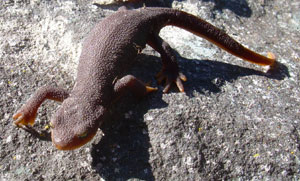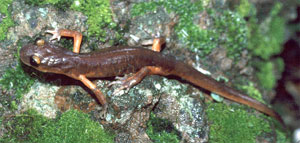 California newt (Taricha torosa)It is about the time of year when, on a hike pretty much anywhere in the Bay Area, you can turn over a rock or a log and find a salamander. Like frogs, the breeding habits of salamanders coincide with the seasonally wet weather of the spring time; and as amphibians, water is essential to their livelihood and reproduction. One species of Bay Area salamander in particular, the California newt (Taricha torosa) is especially easy to see this time of year, and you can see them by the hundreds in ponds, mating and laying eggs. Newts belong to a special group of salamanders that can alter their appearance based on conditions and seasons: during this time of year, you’ll likely spot them in their aquatic morph (part of reproduction and early growth); during drier times, the newt acquires what’s called a terrestrial morph (foraging about on land). Aside from newts, we also have a diversity of fully terrestrial lung-less salamanders that aren’t as easy to find, but do tell an interesting story.
California newt (Taricha torosa)It is about the time of year when, on a hike pretty much anywhere in the Bay Area, you can turn over a rock or a log and find a salamander. Like frogs, the breeding habits of salamanders coincide with the seasonally wet weather of the spring time; and as amphibians, water is essential to their livelihood and reproduction. One species of Bay Area salamander in particular, the California newt (Taricha torosa) is especially easy to see this time of year, and you can see them by the hundreds in ponds, mating and laying eggs. Newts belong to a special group of salamanders that can alter their appearance based on conditions and seasons: during this time of year, you’ll likely spot them in their aquatic morph (part of reproduction and early growth); during drier times, the newt acquires what’s called a terrestrial morph (foraging about on land). Aside from newts, we also have a diversity of fully terrestrial lung-less salamanders that aren’t as easy to find, but do tell an interesting story.
 Monterey salamander (Ensatina eschscholtzii)The biodiversity of California is unique in many ways, and, luckily, scientists have been working for over 100 years to document and better understand the biotic content of this state. In studying the distribution of one lung-less salamander, the Monterey salamander (Ensatina eschscholtzii), scientists began to recognize a pattern: different subspecies of Ensatina eschscholtzii-- which look very different on the outside-- were tightly distributed along the coastal and Sierran mountain ranges with slightly overlapping distributions of different subspecies going north to south. The great, dry Central Valley is devoid of Ensatina, but the two north-south ranges of Ensatina eventually touch in the Peninuslar ranges just south of Bakersfield. It seems that, all throughout this species ring, different subspecies have no problems interbreeding, but what happens when the two arms of the ring touch? What explains this ring pattern? I’ll save those answers for next post…
Monterey salamander (Ensatina eschscholtzii)The biodiversity of California is unique in many ways, and, luckily, scientists have been working for over 100 years to document and better understand the biotic content of this state. In studying the distribution of one lung-less salamander, the Monterey salamander (Ensatina eschscholtzii), scientists began to recognize a pattern: different subspecies of Ensatina eschscholtzii-- which look very different on the outside-- were tightly distributed along the coastal and Sierran mountain ranges with slightly overlapping distributions of different subspecies going north to south. The great, dry Central Valley is devoid of Ensatina, but the two north-south ranges of Ensatina eventually touch in the Peninuslar ranges just south of Bakersfield. It seems that, all throughout this species ring, different subspecies have no problems interbreeding, but what happens when the two arms of the ring touch? What explains this ring pattern? I’ll save those answers for next post…
Nick Pyenson is a PhD candidate at the University of California, Berkeley, in the department of integrative biology and the museum of paleontology.
